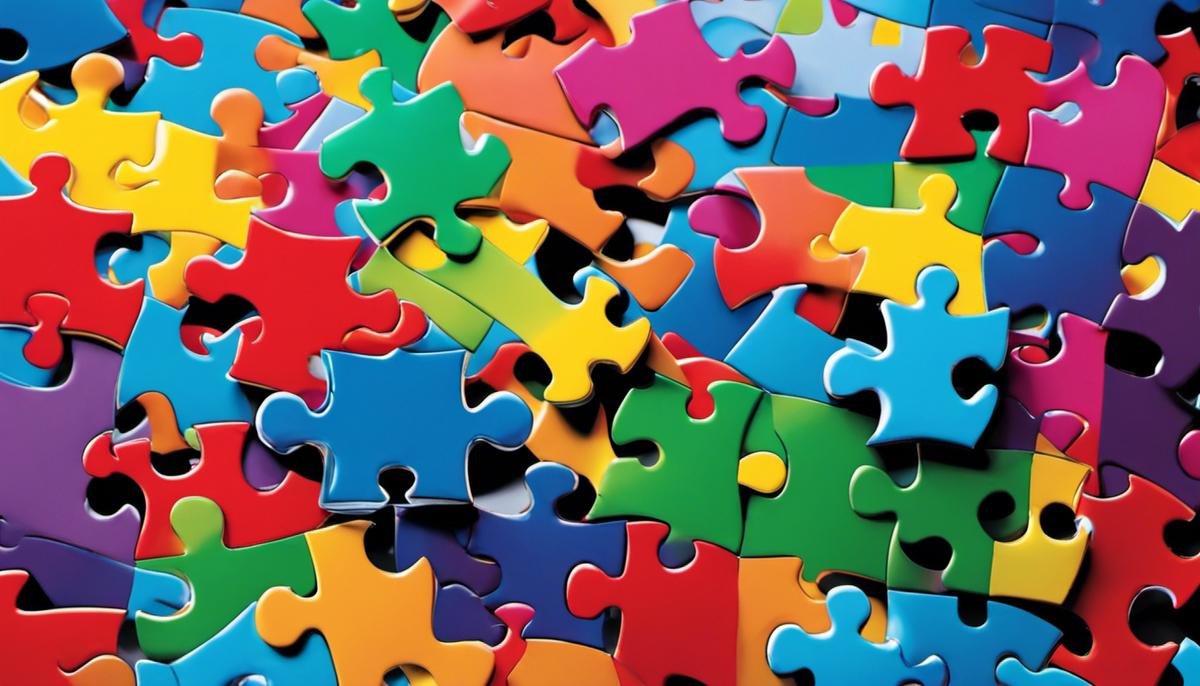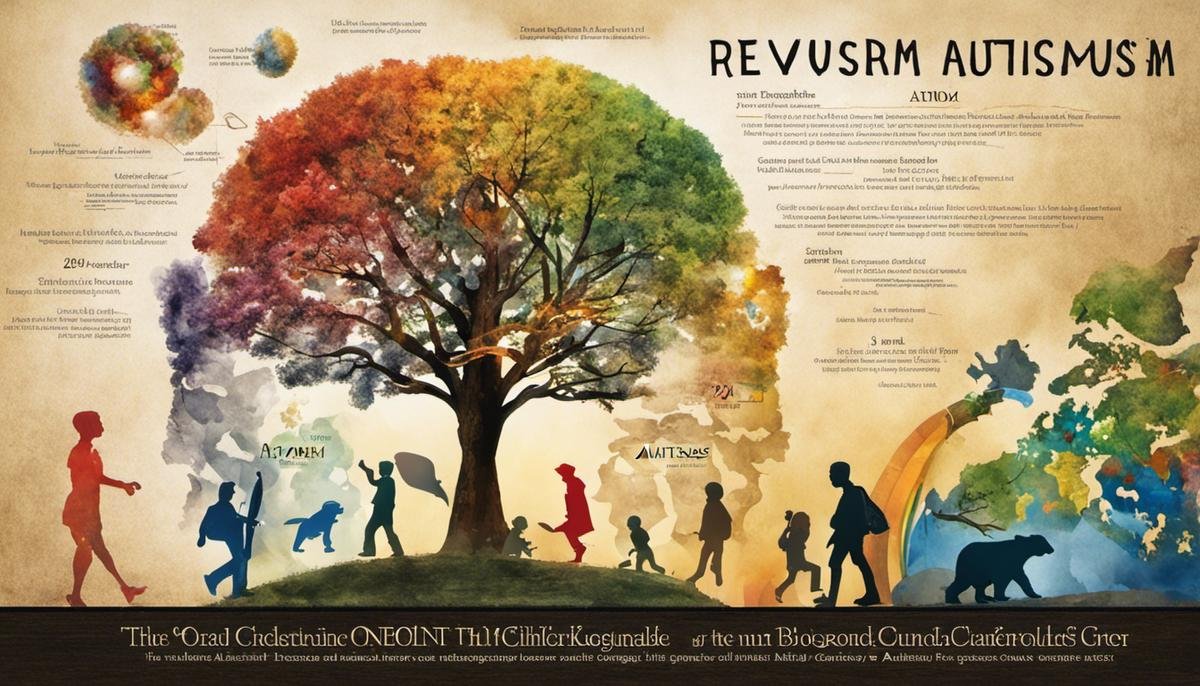
In the realm of developmental disorders, Autism remains a deeply explored yet complex subject that continues to occupy attention and interest around the globe. It is crucial to understand Autism not only from a medical perspective, but also in terms of its sociological and psychological impact on individuals diagnosed with the condition and their families. In this exploration, we delve into the intricacies of Autism, starting from its core understanding, the historical context, and statistical trends, to the potential theories responsible for the increased prevalence. Additionally, we touch on the impact on families and effective coping strategies that can support and benefit those embarking on this lifelong journey.
Autism Explained
Unveiling the Mysteries of Autism: Understanding and Diagnosis
Picture this: Your child marches to the beat of a different drum. They’re unique—beautifully so—but you often find yourself questioning if their differences are parts of their endearing character or signs of something more. Sometimes, they throw tantrum-like behaviors, resist changes, or may struggle to socialize like other children. You may have heard of Autism Spectrum Disorder (ASD), and wondered, “Could my cherub fall within this spectrum?”
But what exactly is Autism? Let’s unveil the suspect behind the query that’s brought you here.
Firstly, it’s essential to know that Autism, or Autism Spectrum Disorder, as it’s formally known, is not a disease. It’s a neurological condition that presents itself from early childhood and intimately shapes how a person perceives the world. Characteristics display themselves as varying degrees of challenges in social interaction, communication, and sometimes repetitive behaviors. A fascinating point is, no two individuals with Autism are alike. It’s like a rainbow spectrum — each person boasting a unique blend of colors.
Autism lives in the brain, but it is not a personality choice or the result of parenting techniques. It’s crucial to keep these points clear from the onset as deep-seated misconceptions, unfortunately, still loom large in society.
So, how does one go about getting a formal diagnosis?
You may have rightfully started puzzling out the pieces already. Has your little one sprouted some behaviors as mentioned previously? It might be time to consult a pediatrician or a specialist. Proactive action is critical, as early intervention generally curtails undesirable future scenarios.
Diagnosis typically progresses across two stages. Initially, a developmental screening during a “well-child” check-up helps highlight any issues. It involves a short test to ascertain if the child learns basic skills timely, or if they have delays. The American Academy of Pediatrics recommends that kids get screened for developmental delays during regular check-ups at 9,18, and 24 or 30 months. Particular attention should be paid to Autism screening at 18 and 24 months or whenever a parent or provider has a concern.
If the pediatrician spots possible signs of Autism during this screening, a comprehensive diagnostic evaluation is the next step. It’s a thorough review that may involve a team, including a psychologist, neurologist, psychiatrist, or other professionals skilled in diagnosing ASD.
Parents’ and other caregivers’ inputs form an essential part of the diagnosis arsenal. Observations about the child’s behavior and development are vital data points since who better to understand a child than their caregivers? Interestingly, sometimes the evaluators also interact with the child, playing and speaking to them, noting how they learn, talk, behave, and move.
Following this, the data gathered is cross-referenced with the DSM-5 (Diagnostic and Statistical Manual of Mental Disorders) criteria to reach a final conclusive diagnosis.
These steps may sound overwhelming, but remember, your journey is not alone. The process is well-established, and an entire community of health professionals, educators, and fellow parents is there with open arms, ready to support at each step.
Understanding If your bundle of joy falls within the Autism spectrum can seem daunting, but gaining the knowledge arms you with the power to help your child thrive. Eage to learn more? Look out for more content that shines the light on understanding Autism, being there for your child, and ensuring you prioritize your wellbeing too. The love for your unique little one overpowering every challenge—now that’s an extraordinary parenting superpower!

Historical Context of Autism
The Evolution of Autism Understanding and Diagnosis: Routes to Building a More Acceptive Society
Autism Spectrum Disorder (ASD) has been part of the human experience since time immemorial, but it’s only relatively recent that we’ve started to fully understand and diagnose it. This journey has been enlightening, not just for the medical community, but for parents, caregivers and the society at large as well.
Way back in the early 20th century, the term ‘autism’ was vaguely used by psychologists to describe certain behavioral traits, often mistaken for childhood schizophrenia. It was Dr. Leo Kanner and Dr. Hans Asperger who first coined the term ‘Autism’ as we know it today, back in the 1940s, albeit with very contrasting theories.
However, the understanding and diagnosis of Autism has significantly evolved from these early notions. It was only in 1980 that Autism was formally recognized as a specific disorder in the Diagnostic and Statistical Manual of Mental Disorders (DSM). Previously, most children considered to be on the spectrum were misunderstood and categorized under a cluster of psychopathological conditions.
The 1987 edition of DSM further borrowed from Dr. Kanner’s perception of Autism and introduced refined criteria for diagnosis, emphasizing the early onset of symptoms. Research and understanding continued to develop, leading to a significant shift in 1994, when Asperger’s Syndrome was introduced as a separate entity within the ASD umbrella in DSM-4.
However, the understanding of Autism took a giant leap with the introduction of the DSM-5
in 2013. In this updated version, Asperger’s Syndrome and PDD-NOS were amalgamated into the singular, broader diagnosis of Autism Spectrum Disorder, aiming at a more detailed and nuanced understanding of the condition.
Parallel to the transformation in the medical understanding of Autism, there has been a progressive change in societal perceptions as well. The outdated and damaging myths about children with Autism ‘lacking emotions’ or ‘preferring solitude’ have been extensively debunked.
Education about ASD for teachers, parents, and even students is now widely promoted, with the aim to cultivate a more inclusive and understanding environment. Hospitals, clinics, and support centers are working relentlessly to provide multidisciplinary care and intervention services to aid the development and quality of life for those diagnosed with ASD.
In recent years, the media has also played an essential role in shaping a more positive narrative around Autism, through movies, documentaries, and articles focusing on the strength, talent, and personality of those on the spectrum, instead of limiting them to their diagnosis.
Looking forward, it’s clear that the understanding and diagnosis of Autism will continue to progress. Emerging areas of research like genetics and neurobiology are contributing significantly to our expanding knowledge of Autism. As we continue to learn more about the intricate nuances of this condition, a world that fully accepts and celebrates neurodiversity comes closer into view.
As parents, caregivers, educators, and supporters, we all are collectively part of this journey, and each step forward illuminates the path for those who follow. The evolving understanding of Autism is a testament to our growing as individuals and as a society. As we continue to broaden our perspectives and extend our support, we ensure a brighter and more inclusively colored future for all children, irrespective of where they lie on the spectrum.

Statistical Trends in Autism Prevalence
Surging Autism Rates: A Look at the Latest Statistics
As we delve deeper into the world of Autism Spectrum Disorder (ASD), the research landscape on this complex condition keeps expanding, enabling a better understanding and more inclusive conversation on ASD. Among the key areas of interest in this context are the latest statistics on the rising prevalence of Autism. It’s crucial to stay updated on these trends, as they help shape public health strategies, influence policy making and aid in spreading awareness.
So, what do the latest numbers tell us?
According to the Centers for Disease Control and Prevention’s (CDC) surveillance, Autism prevalence in the United States has been steadily increasing. The latest estimates, released in March 2020, suggest 1 in 54 children are diagnosed with Autism, a notable increase from the 1 in 59 stat recorded in 2018.
This surge is not just confined to the United States but is observable globally. Studies from countries like South Korea and Japan mirror this rise, pointing to a growing and universal trend.
Contrary to the popular speculation, this rise in Autism rates does not necessarily indicate a sudden explosion of the condition. Instead, it could be attributed to more sensitive and advanced screening techniques, improved awareness, and changes in diagnostic criteria, which now recognize a broader range of symptoms and behaviors under the Autism spectrum.
While the overall increase is undeniable, the statistics also reveal a continued disparity between boys and girls. Boys are still about four times more likely to be diagnosed with ASD than girls. This discrepancy may reflect lingering biases in diagnostic procedures, which have been historically based on male-centric Autism models, underlining the need for changes in our approach to diagnosis.
Geographic and racial disparities continue to be prevalent too. Minority communities have often been underrepresented in Autism diagnoses, due to several factors such as access to healthcare, language barriers, or cultural stigma. Nevertheless, recent initiatives and policies aim to bridge this gap and foster inclusivity.
Turning our attention to age, the majority of children are still diagnosed after the age of 4, even though Autism can be reliably diagnosed as early as age 2. This highlights the urgent need for increased awareness about early identification and intervention, which are crucial for better outcomes.
The statistics certainly give insight into the evolving landscape of Autism diagnoses and prevalence. But let’s remember, behind every number is a child, a family, a story. There’s an ocean of talent, opportunity, and untapped potential that exist within these individuals that is just waiting to be explored and celebrated.
As each child with ASD paints the world with their unique colors, it becomes our shared responsibility as a community to ensure a brighter and more inclusive future for them – full of endless possibilities, unlimited support, and unconditional acceptance. Because each one of them matters. Each person with Autism brings something special and irreplaceable to our world, making it a wonderfully diverse and beautiful place.
But the first step to that, is understanding. Understanding the prevalence, the disparities, and the opportunities that lie ahead. The rising Autism rates deliver a message that is crystal clear – we have a long journey ahead, but together, we can create a tomorrow that recognizes, embraces, and nurtures every single hue of the Autism spectrum.

Possible Causes for Increased Autism Prevalence
Why is There an Apparent Increase in Autism Diagnoses?
Parenting doesn’t come with an instruction manual, and nothing could prepare parents for a diagnosis of Autism Spectrum Disorder (ASD) in their child. Often, the increasing incidence of Autism diagnoses seems alarming to many, sparking conversations about why this is happening. While the roots of Autism are still a subject of active research, several compelling factors might explain this apparent rise in diagnoses.
Current statistics reveal a steady increase in Autism rates, both in the United States and globally. According to the Centers for Disease Control and Prevention (CDC), one in 54 children was identified with ASD as of 2020, a numerical increase compared to previous years. Now, it would be simplistic, and potentially misleading, to attribute this apparent surge to an ‘epidemic’ of Autism. Instead, it’s likely that a range of other factors contribute to these numbers.
Consider, as an example, the evolution of Autism screening and diagnostic techniques over the past few decades. As knowledge about ASD has grown, so have our methods of identifying it. Once-overlooked signals are now considered indicative, and children who might once have been labeled merely ‘quirky’ are now correctly diagnosed. Consequently, our increased ability to recognize ASD is undoubtedly contributing to the rise in diagnoses.
Coinciding with this, continuous revisions of the diagnostic criteria, such as those established in the DSM-5, have expanded the spectrum of Autism. Earlier, many high-functioning individuals might not have received an Autism diagnosis due to a limited understanding of the disorder’s breadth. But with a broader Autism Spectrum in DSM-5, more individuals now rightfully receive a diagnosis.
Furthermore, it’s noteworthy that diagnosis rates can vary significantly based on gender, geographical location, and ethnicity. According to one CDC study, boys are approximately four times more likely to be diagnosed with Autism than girls, suggesting potential gender-based disparities in diagnostic practices. Moreover, diagnostic rates can differ widely from state to state, indicating that local awareness and resource access may affect diagnoses.
Recognizing these discrepancies could be vital in improving the diagnostic process and ensuring those who need support receive it regardless of their gender, ethnicity, or location. It further underscores the need for community education and awareness creation about Autism, especially in underprivileged or marginalized communities.
On a brighter note, the recent rise in Autism diagnoses also signals a positive shift in societal norms and perceptions. More than ever before, individuals with Autism are accepted and included, not ostracized. Gaining an Autism diagnosis can open doors to critical resources, such as tailored education plans, therapy options, and various forms of support. The growth in diagnoses, then, can reflect that society increasingly acknowledges, assists, and embraces neurodiversity.
In essence, the increase in Autism diagnoses could be symptomatic of progress rather than an epidemic. It’s a testament to improved identification processes, elevated awareness, and evolving societal attitudes towards Autism. Armed with this understanding, we can continue to promote inclusivity, support those diagnosed with Autism, and continue learning about this complex, fascinating developmental disorder. Keep in mind that knowledge is a seed that, once planted, can lead to a healthier, more tolerant world. This journey isn’t effortless, but it’s worth every step.
As parents, caregivers, educators, and supportive neighbors, let’s nurture the seed of understanding, and create a flourishing garden where children with Autism can thrive. Indeed, each one of us can contribute to a brighter and more inclusive future for individuals with Autism. It all starts with acceptance and understanding, which are arguably the best gifts one can offer.

Impact on Family and Coping Strategies
Optimizing the Home Environment
After receiving an Autism diagnosis for a child, it becomes pertinent for families to make adaptations to their home environment. Remember, a sensory-friendly space can make a world of difference for a child with Autism. Keep the home organized and create specific areas for different activities, such as a quiet space for relaxation, an area for play, and a spot for studying. Use visual aids like charts and labels to help keep things structured.
Addressing Communication Challenges
Communication might be one of the hurdles for a child with Autism. Many children on the spectrum might find it difficult to express themselves or understand others. As a family, you can find ways to surmount these challenges. Use simple, clear language when speaking and be patient, allowing your child time to process information. Visual aids, sign language, or technological devices can also be leveraged to facilitate communication.
Establishing Routine and Structure
Children with Autism often find comfort in routine, so ensure that a consistent daily routine is in place. This might include regular times for meals, play, homework, and sleep. Of course, the spontaneous happenstances of life mean it’s not always possible to stick to a routine, so gradually introducing changes can help your child adapt.
Finding the Right Therapies and Interventions
There are several therapeutic approaches, like Applied Behavior Analysis (ABA), Occupational Therapy (OT), Speech and Language Therapy (SLT), and others that can dramatically enhance quality of life for a child with Autism. Each child is unique and may respond differently to various treatments. Familiarize yourselves with these methods and opt for the ones that best suit your child’s needs.
Joining Support Groups
Joining Autism support groups can be tremendously helpful in navigating this journey. These platforms not only offer a chance to meet other families going through similar experiences, but they also provide tools, resources, and professional advice that can lighten your journey substantially.
Emphasizing on Social Skills
Fostering social skills is another area that requires attention. Provide opportunities for your child to interact with others, be it through shared activities, play dates, or family gatherings. Rehearsing scenarios and role-playing can also help children learn appropriate social behavior.
Embracing the Journey
Last but not least, it’s imperative for families to remember that while a diagnosis of Autism can be overwhelming, it doesn’t alter the fact that the child is incredibly unique and loved. Embrace this journey, complete with its ups and downs, and celebrate the small victories along the way. Love, patience, and understanding can provide the strongest foundation for your child as they navigate life with Autism.
Empowering your child and coping with the diagnosis requires a mix of optimism, education, patience, and love. It’s a path filled with challenges, but alongside these are triumphs. Let’s not forget that joy is often discovered in the most unexpected places, in the smallest of moments, and in the quietest of triumphs. Remember, you are not alone on this journey, and your family’s strength and unity will be your beacon in these uncharted terrains.

While our understanding of Autism has significantly improved, there remains much to discover in our ongoing quest to fully understand this complex disorder. This journey begins with an exploration into its history, statistics, and possible factors contributing to its increased prevalence, and ends with the ways families can navigate the challenge presented by Autism. Indeed, beyond statistics and medical research, we must remember that behind each diagnosed individual is a family learning to adjust and strengthen their resilience. Through consistent support, care, and understanding, it is possible to not only aid those diagnosed with Autism but also enrich their lives and ours in immeasurable ways.




